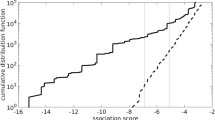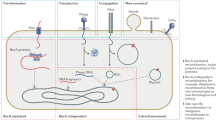Abstract
Horizontal gene transfer (HGT) has a major impact on the evolution of prokaryotic genomes, as it allows genes evolved in different contexts to be combined in a single genome, greatly enhancing the ways evolving organisms can explore the gene content space and adapt to the environment. A systematic analysis of HGT in a large number of genomes is of key importance in understanding the impact of HGT in the evolution of prokaryotes. We developed a method for the detection of genes that potentially originated by HGT based on the comparison of BLAST scores between homologous genes to 16S rRNA-based phylogenetic distances between the involved organisms. The approach was applied to 697 prokaryote genomes and estimated that in average approximately 15% of the genes in prokaryote genomes originated by HGT, with a clear correlation between the proportion of predicted HGT genes and the size of the genome. The methodology was strongly supported by evolutionary relationships, as tested by the direct phylogenetic reconstruction of many of the HGT candidates. Studies performed with Escherichia coli W3110 genome clearly show that HGT proteins have fewer interactions when compared to those predicted as vertical inherited, an indication that the number of protein partners imposes limitations to horizontal transfer. A detailed functional classification confirms that genes related to protein translation are vertically inherited, whereas interestingly, transport and binding proteins are strongly enriched among HGT genes. Because these genes are related to the cell exchange with their environment, their transfer most likely contributed to successful adaptation throughout evolution.






Similar content being viewed by others
Availability of Data and Materials
All data generated or analyzed during this study are included in this published article and its additional files.
References
Arama DP, Soualmia F, Lisowski V, Longevial J-F, Bosc E, Maillard LT, Martinez J, Masurier N, El Amri C (2015) Pyrido-imidazodiazepinones as a new class of reversible inhibitors of human kallikrein 7. Eur J Med Chem 93:202–213. https://doi.org/10.1016/j.ejmech.2015.02.008
Bosi E, Fondi M, Orlandini V, Perrin E, Maida I, de Pascale D, Tutino ML, Parrilli E, Lo Giudice A, Filloux A, Fani R (2017) The pangenome of (Antarctic) Pseudoalteromonas bacteria: evolutionary and functional insights. BMC Genom 18:93. https://doi.org/10.1186/s12864-016-3382-y
Boucher Y, Bapteste E (2009) Revisiting the concept of lineage in prokaryotes: a phylogenetic perspective. Bioessays 31:526–536. https://doi.org/10.1002/bies.200800216
Comas I, Moya A, Azad RK, Lawrence JG, Gonzalez-Candelas F (2006) The evolutionary origin of Xanthomonadales genomes and the nature of the horizontal gene transfer process. Mol Biol Evol 23:2049–2057. https://doi.org/10.1093/molbev/msl075
Cordero OX, Hogeweg P (2009) The impact of long-distance horizontal gene transfer on prokaryotic genome size. PNAS 106:21748–21753. https://doi.org/10.1073/pnas.0907584106
Cuecas A, Kanoksilapatham W, Gonzalez JM (2017) Evidence of horizontal gene transfer by transposase gene analyses in Fervidobacterium species. PLoS ONE 12:e0173961. https://doi.org/10.1371/journal.pone.0173961
Dagan T, Artzy-Randrup Y, Martin W (2008) Modular networks and cumulative impact of lateral transfer in prokaryote genome evolution. PNAS 105:10039–10044. https://doi.org/10.1073/pnas.0800679105
Doolittle WF, Bapteste E (2007) Pattern pluralism and the tree of life hypothesis. PNAS 104:2043–2049. https://doi.org/10.1073/pnas.0610699104
Edgar RC (2004) MUSCLE: multiple sequence alignment with high accuracy and high throughput. Nucleic Acids Res 32:1792–1797. https://doi.org/10.1093/nar/gkh340
Felsenstein J, Churchill GA (1996) A Hidden Markov Model approach to variation among sites in rate of evolution. Mol Biol Evol 13:93–104. https://doi.org/10.1093/oxfordjournals.molbev.a025575
Gogarten JP, Townsend JP (2005) Horizontal gene transfer, genome innovation and evolution. Nat Rev Microbiol 3:679–687. https://doi.org/10.1038/nrmicro1204
Gophna U, Doolittle WF, Charlebois RL (2005) Weighted genome trees: refinements and applications. J Bacteriol 187:1305–1316. https://doi.org/10.1128/JB.187.4.1305-1316.2005
Higgins CF, Hyde SC, Mimmack MM, Gileadi U, Gill DR, Gallagher MP (1990) Binding protein-dependent transport systems. J Bioenerg Biomembr 22:571–592. https://doi.org/10.1007/BF00762962
Hily J-M, Demanèche S, Poulicard N, Tannières M, Djennane S, Beuve M, Vigne E, Demangeat G, Komar V, Gertz C, Marmonier A, Hemmer C, Vigneron S, Marais A, Candresse T, Simonet P, Lemaire O (2017) Metagenomic-based impact study of transgenic grapevine rootstock on its associated virome and soil bacteriome. Plant Biotechnol J. https://doi.org/10.1111/pbi.12761
Iqbal A, Goldfeder MB, Marques-Porto R, Asif H, Souza JG de, Faria F, Chudzinski-Tavassi AM (2017) Revisiting antithrombotic therapeutics; sculptin, a novel specific, competitive, reversible, scissile and tight binding inhibitor of thrombin. Sci Rep 7:1431. https://doi.org/10.1038/s41598-017-01486-w
Jain R, Rivera MC, Lake JA (1999) Horizontal gene transfer among genomes: the complexity hypothesis. PNAS 96:3801–3806. https://doi.org/10.1073/pnas.96.7.3801
Jeltsch A, Pingoud A (1996) Horizontal gene transfer contributes to the wide distribution and evolution of type II restriction-modification systems. J Mol Evol 42:91–96
Jeong H, Nasir A (2017) A preliminary list of horizontally transferred genes in prokaryotes determined by tree reconstruction and reconciliation. Front Genet 8:112. https://doi.org/10.3389/fgene.2017.00112
Koonin EV, Wolf YI (2008) Genomics of bacteria and archaea: the emerging dynamic view of the prokaryotic world. Nucleic Acids Res 36:6688–6719. https://doi.org/10.1093/nar/gkn668
Kurland CG, Canback B, Berg OG (2003) Horizontal gene transfer: a critical view. PNAS 100:9658–9662. https://doi.org/10.1073/pnas.1632870100
Lagesen K, Hallin P, Rødland EA, Staerfeldt H-H, Rognes T, Ussery DW (2007) RNAmmer: consistent and rapid annotation of ribosomal RNA genes. Nucleic Acids Res 35:3100–3108. https://doi.org/10.1093/nar/gkm160
Lassmann T, Frings O, Sonnhammer ELL (2009) Kalign2: high-performance multiple alignment of protein and nucleotide sequences allowing external features. Nucleic Acids Res 37:858–865. https://doi.org/10.1093/nar/gkn1006
Lawrence JG, Ochman H (1997) Amelioration of bacterial genomes: rates of change and exchange. J Mol Evol 44:383–397. https://doi.org/10.1007/PL00006158
Lawrence JG, Roth JR (1996) Selfish operons: horizontal transfer may drive the evolution of gene clusters. Genetics 143:1843–1860
Lima WC, Varani AM, Menck CFM (2009) NAD biosynthesis evolution in bacteria: lateral gene transfer of kynurenine pathway in Xanthomonadales and Flavobacteriales. Mol Biol Evol 26:399–406. https://doi.org/10.1093/molbev/msn261
Martins-Pinheiro M, Lima WC, Asif H, Oller CA, Menck CFM (2016) Evolutionary and functional relationships of the dha regulon by genomic context analysis. PLoS ONE 11:e0150772. https://doi.org/10.1371/journal.pone.0150772
Matassi G (2017) Horizontal gene transfer drives the evolution of Rh50 permeases in prokaryotes. BMC Evol Biol 17:2. https://doi.org/10.1186/s12862-016-0850-6
McInerney JO, Cotton JA, Pisani D (2008) The prokaryotic tree of life: past, present… and future? Trends Ecol Evol 23:276–281. https://doi.org/10.1016/j.tree.2008.01.008
Meehan CJ, Beiko RG (2012) Lateral gene transfer of an ABC transporter complex between major constituents of the human gut microbiome. BMC Microbiol 12:248. https://doi.org/10.1186/1471-2180-12-248
Mrázek J, Karlin S (1999) Detecting alien genes in bacterial genomes. Ann NY Acad Sci 870:314–329
Mykowiecka A, Szczesny P, Gorecki P (2017) Inferring gene-species assignments in the presence of horizontal gene transfer. IEEE/ACM Trans Comput Biol Bioinform. https://doi.org/10.1109/TCBB.2017.2707083
Nakamura Y, Itoh T, Matsuda H, Gojobori T (2004) Biased biological functions of horizontally transferred genes in prokaryotic genomes. Nat Genet 36:760–766. https://doi.org/10.1038/ng1381
Pál C, Papp B, Lercher MJ (2005) Adaptive evolution of bacterial metabolic networks by horizontal gene transfer. Nat Genet 37:1372–1375. https://doi.org/10.1038/ng1686
Peterson JD, Umayam LA, Dickinson T, Hickey EK, White O (2001) The comprehensive microbial resource. Nucleic Acids Res 29:123–125
Podell S, Gaasterland T (2007) DarkHorse: a method for genome-wide prediction of horizontal gene transfer. Genome Biol 8:R16. https://doi.org/10.1186/gb-2007-8-2-r16
Podell S, Gaasterland T, Allen EE (2008) A database of phylogenetically atypical genes in archaeal and bacterial genomes, identified using the DarkHorse algorithm. BMC Bioinformatics 9:419. https://doi.org/10.1186/1471-2105-9-419
Ragan MA (2001) Detection of lateral gene transfer among microbial genomes. Curr Opin Genet Dev 11:620–626
Rivera MC, Jain R, Moore JE, Lake JA (1998) Genomic evidence for two functionally distinct gene classes. Proc Natl Acad Sci USA 95:6239–6244
Ros VI, Hurst GD (2009) Lateral gene transfer between prokaryotes and multicellular eukaryotes: ongoing and significant? BMC Biol 7:20. https://doi.org/10.1186/1741-7007-7-20
Shannon P, Markiel A, Ozier O, Baliga NS, Wang JT, Ramage D, Amin N, Schwikowski B, Ideker T (2003) Cytoscape: a software environment for integrated models of biomolecular interaction networks. Genome Res 13:2498–2504. https://doi.org/10.1101/gr.1239303
Tamura K, Stecher G, Peterson D, Filipski A, Kumar S (2013) MEGA6: molecular evolutionary genetics analysis version 6.0. Mol Biol Evol 30:2725–2729. https://doi.org/10.1093/molbev/mst197
Williams KP, Gillespie JJ, Sobral BWS, Nordberg EK, Snyder EE, Shallom JM, Dickerman AW (2010) Phylogeny of gammaproteobacteria. J Bacteriol 192:2305–2314. https://doi.org/10.1128/JB.01480-09
Yin Z, Zhu B, Feng H, Huang L (2016) Horizontal gene transfer drives adaptive colonization of apple trees by the fungal pathogen Valsa mali. Sci Rep 6:33129. https://doi.org/10.1038/srep33129
Zhaxybayeva O, Swithers KS, Lapierre P, Fournier GP, Bickhart DM, DeBoy RT, Nelson KE, Nesbø CL, Doolittle WF, Gogarten JP, Noll KM (2009) On the chimeric nature, thermophilic origin, and phylogenetic placement of the thermotogales. Proc Natl Acad Sci USA 106:5865–5870. https://doi.org/10.1073/pnas.0901260106
Funding
This project received financial support from Conselho Nacional de Desenvolvimento Científico e Tecnológico (CNPq, Brasília, DF, Brazil) and Comissão de Aperfeiçoamento do Ensino Superior (CAPES, Brasília, DF, Brazil) and Foundation for Research Support of the State of Sao Paulo (FAPESP, São Paulo, SP, Brazil).
Author information
Authors and Affiliations
Contributions
AP, WL, and CM designed and developed the method. CM defined the strategy and supervised. HA, CP, BC, and DB analyzed the data. HA, AP, and CM wrote, discussed, and edited the manuscript. AP, HA, and BC prepared the figures. WL discussed and edited the manuscript.
Corresponding author
Ethics declarations
Competing interests
The authors declare that they have no competing interests.
Additional information
Apuã C. M. Paquola and Huma Asif contributed equally to this manuscript.
Electronic supplementary material
Below is the link to the electronic supplementary material.
Rights and permissions
About this article
Cite this article
Paquola, A.C.M., Asif, H., Pereira, C.A.d.B. et al. Horizontal Gene Transfer Building Prokaryote Genomes: Genes Related to Exchange Between Cell and Environment are Frequently Transferred. J Mol Evol 86, 190–203 (2018). https://doi.org/10.1007/s00239-018-9836-x
Received:
Accepted:
Published:
Issue Date:
DOI: https://doi.org/10.1007/s00239-018-9836-x




